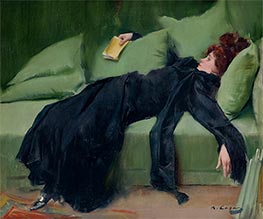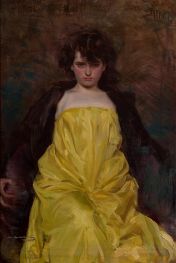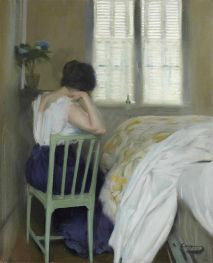
Ramon Casas Giclée Fine Art Prints
1866-1932
Spanish Modernism Painter
He died on 29 February 1932 in Barcelona, 66 years old, after a prolonged battle with tuberculosis. In that final chapter, his career had long since shifted from its earlier adventurousness into a more traditional mode. Yet it would be shortsighted to view his last days as an artist in decline. Even then, he remained a crucial figure who bridged the elegant portraits of aristocrats and the tumultuous scenes of bullfights, protests, and street life that he had rendered in startling detail throughout his life. Although buried at Montjuïc Cemetery, Ramon Casas was never interred in the public mind. His name, once widely celebrated in Barcelona and beyond, persisted as a signpost of Catalonia’s cultural awakening.
Before the illness cut his life short, he found himself at the heart of Barcelona’s art circles, often accompanied by his muse and, eventually, wife, Júlia Peraire. She was twenty-two years younger, a model first and confidante later, stirring some disapproval within his family. The painter’s unflagging commitment to recording the world around him is perhaps no more visible than in those late portraits of Peraire. Their personal relationship, made official in 1922, reflected a quiet but steady defiance of social norms. The public might have talked, but Casas rarely allowed convention to muzzle his sense of curiosity, whether in the selection of his subjects or his private life.
He was also one of the minds behind Els Quatre Gats, the café that blossomed into a nerve center for Barcelona’s avant-garde. Inspired by Montmartre’s Le Chat Noir in Paris, the bar opened in 1897 with Casas as its principal financier. This space, hosted in part by Pere Romeu, showcased art exhibits and became a venue for discussions that fed the modernista movement. Casas’s self-portrait pedaling a tandem bicycle alongside Romeu was once a highlight of the interior, and the café published short-lived magazines to which Casas contributed illustrations. Although Els Quatre Gats closed after only six years, its spirit lived on in the pages of Pèl & Ploma and other initiatives that bore Casas’s unmistakable imprint.
His trajectory, meanwhile, wove in and out of Spain and France. In youth he studied under Carolus Duran and at the Gervex Academy, moving between Paris, Barcelona, and Madrid, gathering influences from academic traditions and Impressionist techniques alike. Each city sharpened his penchant for capturing social realities on canvas, from well-appointed members of high society to raucous street demonstrations. In the latter category, "Garrote Vil," an unsettling painting of an execution, stands out for its blend of contemporary commentary and painterly skill, receiving critical success as far away as Munich. He also embraced the medium of graphic design. His posters, postcards, and advertisements employed the sinuous lines and bold typography that characterized Catalonia’s modernisme.
Yet how did this remarkable ability take root? Casas was born on 4 January 1866 in Barcelona to a father who amassed wealth in Cuba and a mother from a comfortably situated Catalan family. Despite this safety net, he broke away from conventional schooling in 1877 to study under Joan Vicens, displaying early talent for drawing and composition. By his mid-teens he co-founded "L’Avenç" and contributed on-location sketches from Paris, where he further honed his craft and flirted with the cultural ferment of the French capital. His first self-portrait at the Salon des Champs Elysées, portraying him in flamenco attire, sealed his acceptance into the Societé d’artistes françaises, an early milestone for a teenager already charting an independent path.
His recognition widened as he exhibited to critical praise in Madrid, Berlin, and even Chicago. Around the same time, he befriended fellow artists including Santiago Rusiñol and Miquel Utrillo, with whom he formed a network that helped frame modernisme’s evolution. Casas was intimately linked to the bohemian gatherings at Sitges and Barcelona, consistently unveiling exhibitions that married his crowd scenes, sketches of everyday life, and polished portraits of the upper crust. These paintings offered a candid dialogue between the refined drawing rooms of his wealthy patrons and the unrest that sometimes seethed beyond their walls. An invitation to the circle of Charles Deering, an American collector, led to extended travels in Cuba and the United States, where Casas painted portraits of Deering’s acquaintances.
Over time, he became more entrenched in the cultural landscape of Catalonia. He inherited the monastery of Sant Benet de Bages from his mother, immersing himself in its quiet grandeur. In 1916, he took an active role in restoring Tamarit, another project backed by Deering. Frequent exhibitions at Barcelona’s Sala Parés, often alongside Rusiñol and Enric Clarasó, sustained his public profile. Still, as modern art propelled new talents such as Pablo Picasso to the forefront, Casas’s mature style trended toward the academic, no longer carrying the sharp edge of his earlier pieces. Although the innovative fervor of his youth had softened, he remained a venerated figure, sought by patrons who admired his technical dexterity and keen capacity to capture likeness and atmosphere alike.
By the end, Casas had traversed a vibrant career that reflected the pulse of a rapidly changing world. He absorbed the influences of Paris, redefined Catalan modernisme through painting and design, and shaped gathering places that encouraged an emerging generation of artists. Even in his final works, he continued to depict the interplay of private and public life with unassuming precision. To stand before a Ramon Casas canvas is to be drawn into an era when Barcelona’s streets clamored for change, and elegant salons withheld their secrets behind plush draperies. His singular journey, from privileged scion to modernista pioneer, endures as testimony to the depth and breadth of Catalan art in the decades around the turn of the 20th century.
Before the illness cut his life short, he found himself at the heart of Barcelona’s art circles, often accompanied by his muse and, eventually, wife, Júlia Peraire. She was twenty-two years younger, a model first and confidante later, stirring some disapproval within his family. The painter’s unflagging commitment to recording the world around him is perhaps no more visible than in those late portraits of Peraire. Their personal relationship, made official in 1922, reflected a quiet but steady defiance of social norms. The public might have talked, but Casas rarely allowed convention to muzzle his sense of curiosity, whether in the selection of his subjects or his private life.
He was also one of the minds behind Els Quatre Gats, the café that blossomed into a nerve center for Barcelona’s avant-garde. Inspired by Montmartre’s Le Chat Noir in Paris, the bar opened in 1897 with Casas as its principal financier. This space, hosted in part by Pere Romeu, showcased art exhibits and became a venue for discussions that fed the modernista movement. Casas’s self-portrait pedaling a tandem bicycle alongside Romeu was once a highlight of the interior, and the café published short-lived magazines to which Casas contributed illustrations. Although Els Quatre Gats closed after only six years, its spirit lived on in the pages of Pèl & Ploma and other initiatives that bore Casas’s unmistakable imprint.
His trajectory, meanwhile, wove in and out of Spain and France. In youth he studied under Carolus Duran and at the Gervex Academy, moving between Paris, Barcelona, and Madrid, gathering influences from academic traditions and Impressionist techniques alike. Each city sharpened his penchant for capturing social realities on canvas, from well-appointed members of high society to raucous street demonstrations. In the latter category, "Garrote Vil," an unsettling painting of an execution, stands out for its blend of contemporary commentary and painterly skill, receiving critical success as far away as Munich. He also embraced the medium of graphic design. His posters, postcards, and advertisements employed the sinuous lines and bold typography that characterized Catalonia’s modernisme.
Yet how did this remarkable ability take root? Casas was born on 4 January 1866 in Barcelona to a father who amassed wealth in Cuba and a mother from a comfortably situated Catalan family. Despite this safety net, he broke away from conventional schooling in 1877 to study under Joan Vicens, displaying early talent for drawing and composition. By his mid-teens he co-founded "L’Avenç" and contributed on-location sketches from Paris, where he further honed his craft and flirted with the cultural ferment of the French capital. His first self-portrait at the Salon des Champs Elysées, portraying him in flamenco attire, sealed his acceptance into the Societé d’artistes françaises, an early milestone for a teenager already charting an independent path.
His recognition widened as he exhibited to critical praise in Madrid, Berlin, and even Chicago. Around the same time, he befriended fellow artists including Santiago Rusiñol and Miquel Utrillo, with whom he formed a network that helped frame modernisme’s evolution. Casas was intimately linked to the bohemian gatherings at Sitges and Barcelona, consistently unveiling exhibitions that married his crowd scenes, sketches of everyday life, and polished portraits of the upper crust. These paintings offered a candid dialogue between the refined drawing rooms of his wealthy patrons and the unrest that sometimes seethed beyond their walls. An invitation to the circle of Charles Deering, an American collector, led to extended travels in Cuba and the United States, where Casas painted portraits of Deering’s acquaintances.
Over time, he became more entrenched in the cultural landscape of Catalonia. He inherited the monastery of Sant Benet de Bages from his mother, immersing himself in its quiet grandeur. In 1916, he took an active role in restoring Tamarit, another project backed by Deering. Frequent exhibitions at Barcelona’s Sala Parés, often alongside Rusiñol and Enric Clarasó, sustained his public profile. Still, as modern art propelled new talents such as Pablo Picasso to the forefront, Casas’s mature style trended toward the academic, no longer carrying the sharp edge of his earlier pieces. Although the innovative fervor of his youth had softened, he remained a venerated figure, sought by patrons who admired his technical dexterity and keen capacity to capture likeness and atmosphere alike.
By the end, Casas had traversed a vibrant career that reflected the pulse of a rapidly changing world. He absorbed the influences of Paris, redefined Catalan modernisme through painting and design, and shaped gathering places that encouraged an emerging generation of artists. Even in his final works, he continued to depict the interplay of private and public life with unassuming precision. To stand before a Ramon Casas canvas is to be drawn into an era when Barcelona’s streets clamored for change, and elegant salons withheld their secrets behind plush draperies. His singular journey, from privileged scion to modernista pioneer, endures as testimony to the depth and breadth of Catalan art in the decades around the turn of the 20th century.
3 Ramon Casas Artworks

Giclée Canvas Print
$68.84
$68.84
SKU: 19897-SSR
Ramon Casas
Original Size:46.5 x 56 cm
Public Collection
Ramon Casas
Original Size:46.5 x 56 cm
Public Collection

Giclée Canvas Print
$55.46
$55.46
SKU: 19905-SSR
Ramon Casas
Original Size:91 x 63 cm
Public Collection
Ramon Casas
Original Size:91 x 63 cm
Public Collection

Giclée Canvas Print
$67.18
$67.18
SKU: 19906-SSR
Ramon Casas
Original Size:61 x 50 cm
Private Collection
Ramon Casas
Original Size:61 x 50 cm
Private Collection